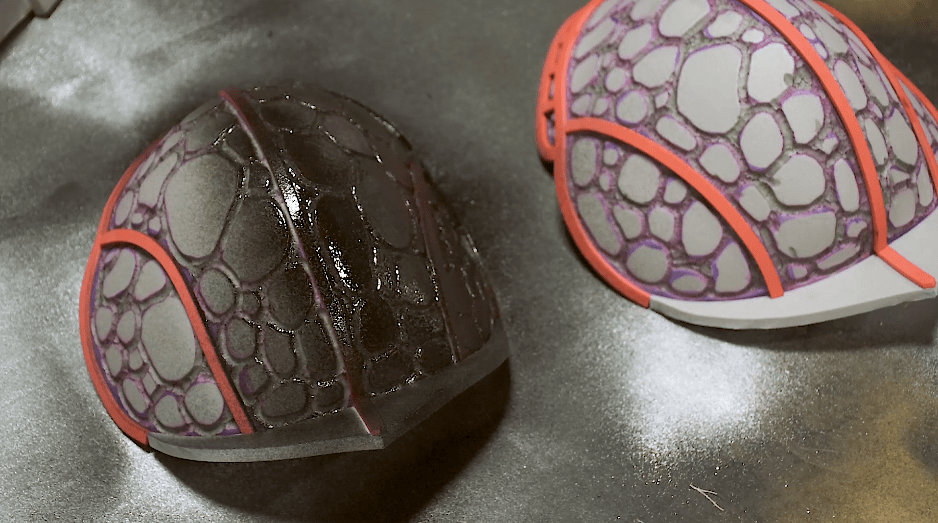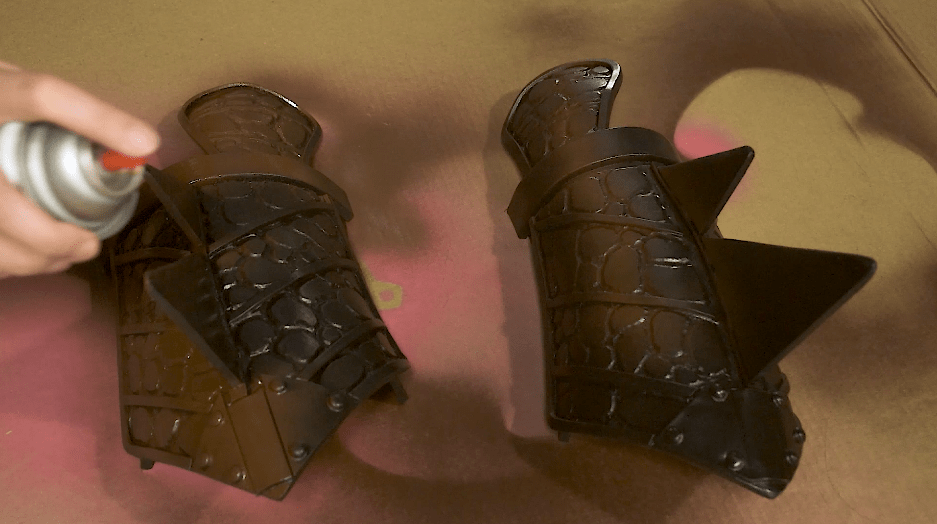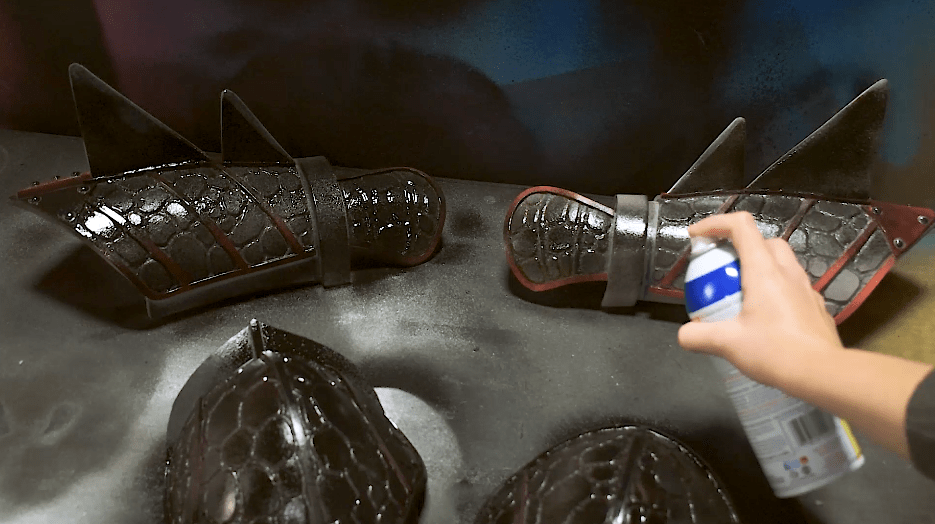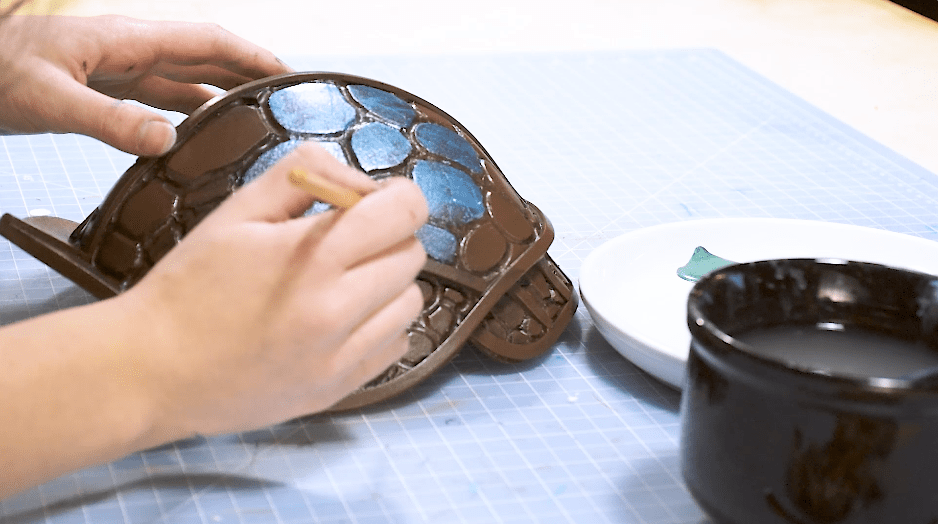During the painting stage of making an armored cosplay, the main goal is to get your EVA foam to stop looking like foam and start looking like metal. While nailing the subtleties in the color of your armor can take a bit of practice and a bit of an artistic touch, you have some choices when it comes to the right process and paint for you. In most cases, you have two main types to pick from: spray paint and acrylics. So how do you know which one to use?
In this post, we’ll list the pros and cons of painting cosplay armor with spray paint vs. acrylics and also explain how a combination of the two can potentially be the perfect mix for your cosplay.
Spray Paint vs. Acrylics on EVA Foam Armor

Before we get started withe pros and cons list, we wanted to go through some quick foam painting basics. First of all, before you paint anything, you need to make sure your foam is sealed with a base layer. Sealing your foam gives it some extra strength, but mostly, it keeps your paint from just sinking into your foam. There are several flexible sealers you can choose from depending on your preferences and your cosplay’s needs: rubberized Plasti-Dip, Flexbond, or PVA/wood glue are just a few examples. Once your foam is sealed, the paint you choose will ultimately depend on what your armor piece is going to do. You might decide to use different types of paint on different armor pieces. Sometimes this is necessary, but other times, you might try to choose one painting technique for a consistent finish. And finally, just about any paint you use will require multiple coats/layers, no matter what.
Now that you’re ready to actually paint, here’s what you need to know about painting with spray paint vs. acrylics on your armor projects.
Spray Paint Pros

- You can get lots of coverage in a short amount of time with spray paint. Spray painting is a pretty fast solution, especially if you’re only using a single color.
- The color on the can is (or should be) the color you get, with no mixing required.
- Metallic spray paints can give you a really realistic metal finish.
- With the right technique, spray painting gives you a very light and even coating that looks professional.
- Spray paint dries fairly quickly in between coats.
- Spray paint gives you bold, opaque colors.
Spray Paint Cons

- You always need to spray paint in a well-ventilated area, spray booth, or with a respirator mask.
- Spray painting takes up a lot of space and can be messy if you’re not careful about overspray. Don’t do this over any nice carpet or other surfaces!
- With the wrong technique (holding the can too close or too far from the foam, heavy strokes, etc.), your foam can end up with build-up and unwanted texture.
- Spray painting is less precise than painting with a brush.
- You’ll have to tape and mask off between each different spray paint color if you’re using more than one.
- On the flip side, you can’t really mix spray paint colors together to create a custom shade.
- Additionally, you might be limited by the range of colors that you can find available.
- Perhaps most importantly, spray paint will crack if you use it on moving parts of your armor. Spray paint isn’t very flexible, and there’s no easy way to add any kind of flex agent to an aerosol can.

- Acrylic Paint Pros
- With acrylic paints, you can paint small details much more precisely with your brush vs. a spray can nozzle.
- Acrylic paints allow you to switch easily between multiple colors on one armor piece.
- Acrylic paints are available in a huge range of colors.
- Even if you can’t find the exact color you want on the shelf, acrylic paints are easy to mix together to create custom shades or to create depth with variations on the same color.
- Acrylic paints are more hands-on.
- Working with acrylic paints, though not completely mess-free, are cleaner than spray paint in many ways. They also require less space.
- On their own, acrylic paints aren’t incredibly flexible, BUT you can easily mix in some fabric medium to give your paint some stretch. This helps stop your paint job from cracking, especially on moving parts.

Acrylic Paint Cons
- Acrylic paint jobs tend to take more time because you’re working by hand with a brush rather than spraying a large area quickly. It all depends on the detail level of your armor.
- Acrylic paint usually requires more coats before the color is truly opaque.
- Acrylic paint can also take longer to dry between coats because its texture is thicker than spray paint.
- Your brush strokes can potentially be more visible.
Spray Paint and Acrylics: A Winning Combination
The choice between spray paint and acrylics for your EVA foam armor should come with a few considerations with each different cosplay. Depending on the armor design, how it moves, and your own personal preferences, your choice may fluctuate between different cosplays. However, we want to pose one more possibility for you: sometimes the best choice is a combination of the two. While this won’t work for every armor suit or piece, sometimes, you can layer spray paint and acrylics for a really detailed, professional result. By laying down a base coat of spray paint and painting with acrylics on top, you can get actually achieve the benefits of each type of paint while downplaying the disadvantages, too. This method will work best on armor that has one main color and then smaller details to paint on top.
While this won’t work for every armor suit or piece, sometimes, you can layer spray paint and acrylics for a really detailed, professional result. By laying down a base coat of spray paint and painting with acrylics on top, you can get actually achieve the benefits of each type of paint while downplaying the disadvantages, too. This method will work best on armor that has one main color and then smaller details to paint on top.
Here’s how it works: after sealing your foam, you can lay down a few base coats of spray paint in your main color. Once that paint is dry, you can use or mix any additional acrylic colors you need for certain areas or details and paint it on top. This method can save you the time of masking off different colors and going over large areas with a brush. For a real-life example, check out our Astrid’s armor painting video to see how we sprayed her pieces brown first and then painted with metallic acrylics to get the right color shifts on the dragon scales. With this combination spray paint and acrylic method, you can get a more professional looking finish that will last.